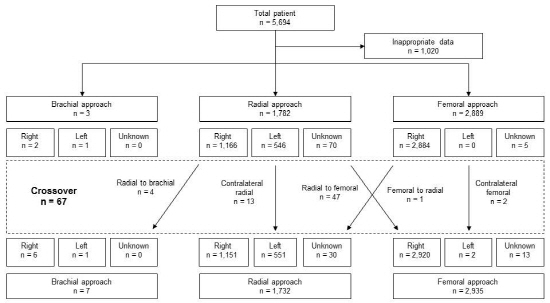| єя«•«ьљƒ : ±Єњђ
|
ЅҐЉцєш»£ - 550323 346 |
| Incidence and Predictors of Crossover from Radial to another Vascular Access Site in Patients Underwent Coronary Intervention: Report from the Transradial Coronary Intervention (TRI) Working Group Retrospective Registry in Korea |
| мЧ∞мДЄлМАнХЩкµР мЫРм£ЉмЭШк≥ЉлМАнХЩкµР1, лПЩмХДлМАнХЩл≥СмЫР2, мГБк≥Дл∞±л≥СмЫР3, лґАм≤ЬмД±к∞Ал≥СмЫР4, к≥†лМАкµђл°Ьл≥СмЫР5, мЭЄнХШлМАл≥СмЫР6, мґ©лґБлМАнХЩл≥СмЫР7, мИЬм≤ЬнЦ•лМАнХЩ м≤ЬмХИл≥СмЫР8, мХДм£ЉлМАл≥СмЫР9, м†ДлВ®лМАнХЩл≥СмЫР10, к∞Хл¶ЙмХДмВ∞л≥СмЫР11, к∞ХмЫРлМАнХЩкµРл≥СмЫР12, лґАмВ∞лМАнХЩл≥СмЫР13, мЭЉмВ∞л∞±л≥СмЫР14, к∞ХлПЩмД±мЛђл≥СмЫР15, мИЬм≤ЬнЦ•лМАнХЩ мДЬмЪЄл≥СмЫР16 |
| мЬ§мШБмІД1, мЭім§АмЫР1, мХИмД±кЈ†1, мЭімКєнЩШ1, мЬ§м†ХнХЬ1, кєАлђінШД2, кєАл≥СмШ•3, кєАнЭђмЧі4, лВШмКємЪі5, л∞ХкЄИмИШ6, л∞∞мЮ•нЩШ7, мЛ†мЫРмЪ©8, мЦСнШХл™®9, м†Хл™ЕнШЄ10, м†ХмГБмЛЭ11, м°∞л≥Сл†ђ12, м∞®кіСмИШ13, мµЬнШДлѓЉ14, нХЬкЈЬл°Э15, нШДлѓЉмИШ16, кЈЄ мЩЄ мЪФк≥®лПЩлІ• мЖМмЧ∞кµђнЪМ мЧ∞кµђмЮР |
Background and Objectives: The use of transradial coronary intervention (TRI) is increasing for its lower rates of major vascular access related complications and the potential for early mobilization. However, the crossover rate from TRI to transfemoral approach was reported between 0% and 12%. Therefore, we evaluated the incidence and predictors of crossover from radial to another vascular access site in patients undergoing percutaneous coronary intervention (PCI) in Korea.
Subjects and Methods: Data for PCI of 5,694 patients were collected in TRI working group retrospective registry from 16 institutes in Korea. Total 1,782 patients attempted with transradial approach were evaluated.
Results: Crossover of vascular access site from radial to another vascular access site was needed in 64 (3.6%) patients: from radial to brachial artery in 4 patients; to contralateral radial artery in 13 patients; from radial to femoral artery in 47 patients. The most common cause for crossover was need of larger guiding catheter (35.8%). Other causes were radial artery loop or tortuosity (15.1%), radial artery spasm (15.1%), hemodynamic instability during PCI (7.5%), complication at access site (7.5%) and accessing artery stenosis or occlusion (5.7%).
Conclusions: In Korea, the rate of access site crossover in patients underwent TRI is low. Need of larger guiding catheter for complex PCI; anatomical factors, spasm and vascular complication of accessing artery; and hemodynamic instability were the predictors of failed TRI.
|
|
|
Warning: getimagesize(/home/virtual/circulationadmin/renewal/econgress/conference/abstract/img_files/Crossover.jpg) [function.getimagesize]: failed to open stream: No such file or directory in /home/virtual/circulationadmin/new/econgress/conference/manage/schedule/view_abstract.php on line 164

|
|





